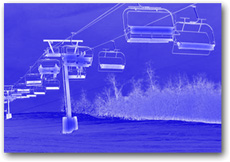
|
|
Did you miss part 1 of this series? of Jim Kenney’s survey of ski lifts.
|
Gondolas can be a superior way to beat brisk mid-winter temperatures. My kids and I repeatedly rode the Skyeship gondola (8 passenger/2500’ approx vertical) at Killington, VT to great advantage over two cold days in February 2001. My group was able to continue to enjoy Great Eastern and the other extra long intermediate trails served by this heated lift far longer than we might have otherwise. Killington has another gondola, the K-1 (8 passenger/1650’ approx vertical), which serves core terrain between the main base and Killington Peak.
As a skiing hayseed from Virginia, I think gondolas still have some cache. When you step into one you’re definitely not in the Blue Ridge anymore. Riding the Aspen/Ajax Mountain, CO gondola (6 passenger/ 3200’ approx vertical) a few years back, there was an even chance you’d hook-up with a stock trader or a minor show biz personage working a deal on a cell phone. That sort of thing caught my attention ten years ago; I hope they’ve banned cell phones from the slopes by now. The excellent view from the lift of downtown Aspen left a more enjoyable impression.
The Aspen gondola, dubbed the Silver Queen by marketing types, embodies for me the kind of ski lift that allows a skier/boarder to repeatedly tackle a big chunk of mountainside in one fell swoop. The set-up there gave me an unexpected feeling of intimacy and accessibility to a mountain with a vertical over 3000’. You could pretty much ski all the terrain, all day long, using just one big, fast lift. Too bad the Aspen scene requires such a fat wallet; the cluster of ski areas there are very attractive. Ajax finally opened their terrain to boarders last year. I’ve never been to Jackson Hole, WY, but I understand their tram gives you the same kind of access to a mountain with a vertical over 4000’.
Gondolas generally stay close to the ground like chairlifts, but some reach heights that can generate a little acrophobia. I can remember riding the old gondola at Gore Mountain, NY in the late 1980s. For a dated northeastern ski lift it rose surprisingly far from Mother Earth, seemingly about 150’. It was replaced in 2000 with a new gondola (8 passenger/2100’ approx vertical). I don’t know if it follows the same line. Whiteface, NY also has a new gondola (8 passenger/2400’ approx vertical). That’s quite a bonanza for two historically frugal NY-state owned ski areas.
I was on the gondola at Stratton, VT during the first year it opened (1989?). In the cabin up to 12 passengers lean their backsides against a stubby half bench. This was a slight disappointment at first, but since the ride was relatively short for such a lift with no more than about 2000’ vertical, it was not inappropriate and I’m sure contributed the slightly higher than normal capacity for such lifts. Stratton is one of the birthplaces of snowboarding. Jake Burton made his first boards nearby in the 1970s. The mountain is tame by some measures, but has some very pleasant intermediate cruising and riding terrain. It’s similar in that way to Mt. Snow, also in southern Vermont.
I spent a slightly frustrating week in January 1997 at Sugarloaf, ME. The mountain has a vertical of around 2800’, but at the time, the only way to get to the very top was by a very old gondola. For weather, mechanical, or whatever reasons it was only open for two brief periods during the 5 days of my visit. They have since removed it and summit access is accomplished by high speed detachable chairs. A number of areas I’ve visited in the past including Park City, UT, Sugarbush, VT, and Wildcat, NH have also abandoned old gondolas for high speed chairs.
American ski areas have embraced the high speed detachable chair lift in a big way over the last 10 to 15 years. It’s efficient, less susceptible to weather closures, and the “detachable” clutch mechanism it stole from gondola and tram designs is very user-friendly during the loading and unloading process. High speed detachable chairlifts come in multiple passenger variants. I believe 8 passengers is the current max. Vail in particular, and Colorado in general, were leading proponents of these chairs in the 1980’s. Vail is covered with them. At last count 14 of the 30+ Vail ski lifts were of the high speed variety.
A couple of years ago I rode the unique high speed Slidebrook quad chairlift at Sugarbush, VT. This chair moves laterally, making a connection with the slopes of Sugarbush North. Riders embark at either end from loading stations located well uphill from the base of each area. Essentially, it replaced a shuttle bus formerly operating between the two bases. This chairlift feels like it moves at about 20 MPH, covering 2 miles in about 11 minutes. I can attest that it generates its own wind chill factor. Much of the terrain it passes over is a protected wilderness area with no downhill ski runs and little access. If that lift ever broke down while loaded with passengers it would be a horror story to evacuate.
You can ride high speed detachable chairs in the mid-Atlantic region. There’s one at Whitetail, PA and two at Snowshoe, WV. One of the high speed detachable quads at Snowshoe provides a very handy ride up the full 1500’ vertical of their Western Territory. A new six passenger high speed chair debuts at Seven Springs, PA this season and represents the first “six-pack” in our area.
High speed gondolas and detachable chairlifts are the current state of the art in US ski lift technology. Both seem to add a few more passengers with each design evolution. I wouldn’t predict much in the way of dramatic near term innovation with ski lifts, since skiing is not a huge growth industry at this time. I see aerial trams as remaining a niche item in the US due to their comparatively low uphill transport capacity. My guess for why there are so many of them in Europe is based on geographic, economic, and historical reasons. Trams/cable cars are ideal for the rugged terrain of the Alps, they are a comfortable attraction for the year round alpine tourist traffic, and 50 years ago the Europeans considered them a better technological choice than chairlifts for steep installation sites. Once the infrastructure was in place, it remained.
I haven’t previously discussed rail type funiculars, inclined railways or cogwheel trains. There are a number of these in use as tourist attractions in the US, but not at ski areas that I know of. A small inclined rail type of lift called the Skimobile was used for decades at the Mt. Cranmore, NH ski area, but it no longer operates. It was installed under the direction of Hannes Schneider, Mt. Cranmore’s legendary ski instructor and Austrian “migr” during the WWII timeframe. Many European alpine resorts continue to utilize elaborate railway systems as summer attractions and major winter ski lifts.
A final comment: This might sound like your mom speaking, but don’t let big lifts go to your head. They are likely to serve unprecedented terrain for visiting mid-Atlantic skiers/boarders. I was thrilled by my first ride up the Snowbird Tram one morning many years ago in Utah. After skiing down just a few hundred yards from the summit I stopped to babble to a friend that this was some of the greatest skiing I’d seen; huge open bowls in one direction and long, steep tree-lined trails in the other. Then I spotted a snow covered rock outcropping nearby and said “watch this.” The ledge had a four or five foot drop-off, which I took with modest speed. When I landed my legs sunk thigh deep in to snow that was like mashed potatoes. I immediately blasted out of both bindings and vaulted forward head first into the soft snow. I was fine, but the dazzling environment led me to blow a cardinal rule by not checking out the landing zone before going for a little air. Once he saw I hadn’t ruined our ski day with an injury, my pal got a big laugh out of my goof.
A quick surf of the web revealed two sites with photos of many of the areas/lifts discussed above. www.chairlift.org contains mostly photos of US lifts. www.photovault.com has a more global scope; search under gondolas, trams, funiculars, etc. Many pictures are unlabeled and this will test your identification skills. [Editor’s note: Garaventa CTEC, a popular manufacturer of ski lifts in America, also has a web site (www.garaventactec.com) with lots of pictures showing different types of upslope transportation.]
Husband, father and retired civilian employee of the Department of Navy, Jim Kenney is a D.C. area native and has been skiing recreationally since 1967. Jim's ski reporting garnered the 2009 West Virginia Division of Tourism's Stars of the Industry Award for Best Web/Internet/E-Magazine Article.

Join the conversation by logging in.
Don't have an account? Create one here.